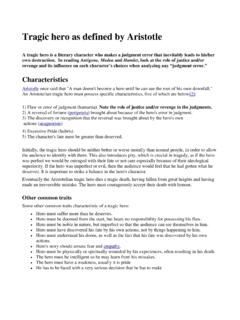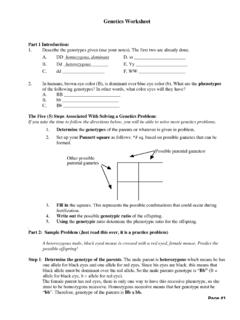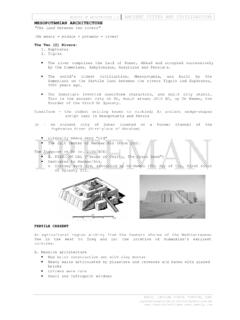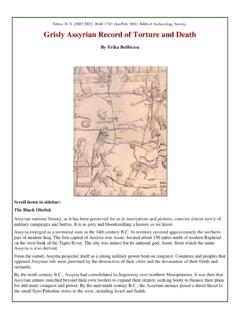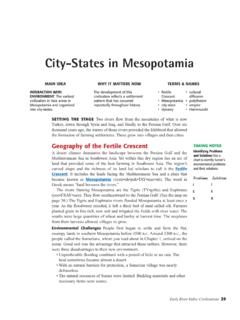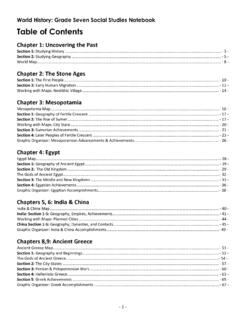Transcription of What are the similarities between River Valley Civilizations?
1 What are the similarities between River Valley Civilizations? By 3500 BCE, relatively large preliterate societies develop along the Indus, Huang He, Nile, and Tigris & Euphrates Rivers. Over time, in permanent to the in complexity Trade expands during this period from local to regional and transregional. With trade you have the exchange of goods, ideas, and technologyFollowing the development of agriculture, society became more Full-time and figures emerge as leaderssuch as toolmakers, miners, and merchants Farming & specialized labor led to and and growing societal complexities lead to the creation of socio-political hierarchyemerges in the first civilizations Social Complexity Women tend to children while men are available for specialist labor upper classes have more (wealth, education, and avoid manual labor)
2 Free commoners create the to sustain the upper classesSlaves (prisoners of war, criminals, debtors) are used as .Leaders claim power by MESOPOTAMIANILERIVERVALLEYS ocial Gender roles / relations Family and kinship Racial and ethnic groups Social and economic classes Social Hierarchy: a system or organization in which people or groups are ranked one above the other according to status or authority Hammurabi scode enforced hierarchies Limited social mobility (based on education) Patriarchy men are the heads of households Women gain power as priestesses or scribes Social classes were high , merchants, lesser Women were not treated equal to men but had more rights than in other societies.
3 First female pharaoh was Leaders, political structures and forms of governance Empires, nations, and nationalism Expansion, collapse, revolts and revolutions city states -Small, independent cities w/ surrounding villages & farms Built defensive walls around cities Conflicts between city - states led to war and unification into empires Warrior-kingsclaimed that they were given power to rule by gods Sargon of Akkadcontrolled trade / resources Hammurabi s Codeis early evidence of law and order Centralizedrule Ruled by Pharaohwho had political and religious power. Dynastieswere created. Determined public works project (irrigation canalsfor agriculture)Interactions Demographics, Disease Migrations, Settlement patterns Technology Mesopotamiameans Land between two rivers (Tigris & EuphratesRiversin modern-day Iraq) Also known as The Fertile Crescent for its yearly flooding and good farmland (irrigation ditches) No geographic barriers to invasion Bronze and iron resources led to metallurgy and the development of more complex tools and weapons.
4 Nileused for trade and agriculture. Irrigationand predicted flooding by calendar. Culture Religion, belief systems, philosophies and ideologies Science and technology Art, music, literature, clothing Polytheistic Zigguratswere monumental architecture that honored local gods Temples also functioned as banks & community centers Priests intervened with gods Education based on trades / crafts most of the population is illiterate Cuneiform earliest writing system Epic of Gilgamesh Epic travels of a king Polytheisticreligion. Believed in afterlife Mummifiedkings and nobility, preformed by priests. Built pyramidsand statues of god.
5 Hieroglyphics(derived from Cuneiform) which were written on papyrus, made from reeds Mathematics and astronomy not as advanced as Mesopotamia. Very accurate calendar, 12 months and 30 days. Used for annual flooding. Knowledge of medicine and surgery because of mummificationEconomic Goods, trade, commerce, and labor systems Agricultural, pastoral, and industrial production Capitalism and socialism Production of goods Economy divided into specialized laborersleads to class divisions Majority of wealth was concentrated in upper levels of social pyramid Efficient transportation on wheeled vehicles & ships facilitated long-distance trade Slave trade Nile used for trade and agriculture.
6 Grew wheat and barley. Traded with Mesopotamia and (YELLOW)RIVERVALLEYS ocial Gender roles / relations Family and kinship Racial and ethnic groups Social and economic classes Aryanswould established a rigid Caste System looked at religion and society closely developed later. Castesystem: Social hierarchy determined at birth. No social mobility Little social interaction between castes Outcasteshold the lowest positions in society Social classes similar to other (god like). and important and lesser , merchants, Fathers arranged marriages, controlled families, daughters sometimes sold into Leaders, political structures and forms of governance Empires, nations, and nationalism Expansion, collapse, revolts and revolutions Government oversaw the public works.
7 Had public works public baths, running water, cow breeding and irrigation. Two most known cities are Harappa and builtusing a grid-like pattern (demonstratescentralizedplanning) Centralized planning They created palaces and tombs. Regulated irrigation Dynastic cycle, Zhou took control in 1000sBCE; beginning classical periodInteractions Demographics, Disease Migrations, Settlement patterns Technology Used the Indus for Irrigation. Dependent on Monsoons Traded with Mesopotamia, Persia and Egypt as evidence by goods Considered themselves the Middle Kingdom center of the world. Not much cultural interaction due to geographic isolationalthough interacted with Pastoral NomadsCulture Religion, belief systems, philosophies and ideologies Science and technology Art, music, literature, clothing Polytheisticbeliefs Reincarnation-belief in rebirth of soul after death.
8 Dharmaand Karma. Early form of Sanskritwriting, based on Cuneiformbut still not deciphered. They have fine art, sculptures, and pottery. Had bronzetool and steal weapons. Polytheisticdeveloped many gods based on natural disasters Sacrificed food and other things to please gods in temples. Writing was done in pictographs, and ideographs over 1000 symbols next to Cuneiform it is the 2ndoriginal writing form Created first books. China had advanced mathematics and Goods, trade, commerce, and labor systems Agricultural, pastoral, and industrial production Capitalism and socialism Production of goods Economy was based on agriculture.
9 Grew wheat, barley, and cotton. Certain percent of food was stored in granaries for public use for droughts Based on agriculture. Grew rice Silkmade by silkworm. Domesticated animals -dogs, pigs, and Choice40%Short Answer20%Document Based Question25%Long Answer15% 1 Question 55 Minutes (including 15 min. for reading the document set) 4 Questions 50 minutes 1 Question (choice among 2) 35 MinutesThere are three different kinds of ree esponse uestions on the AP World History Exam:ocument-ased uestionsong ssay uestionshort nswer uestionsShort Answer Questions are the most simple, but also require the most precision when responding.
10 3 Questions in 40 minutes Each question consists of three parts Each part is worth 1 point No partial credit1. a.) IDENTIFY and EXPLAIN one reason why early civilizations formed along rivers. b.) IDENTIFY and EXPLAIN one similarity in the political structures of Mesopotamia and one other civilizations in the period before 600 BCE. c.) IDENTIFY and EXPLAIN one similarity in the social structures of Mesopotamia and one other civilizations in the period before 600 BCE. Underline the verbs in the question that tell you what to do. Tailor your answer to what is called for in the , "IDENTIFY" asks for a mere , whereas "DISCUSS," "EXPLAIN," or "describe" call for more.

